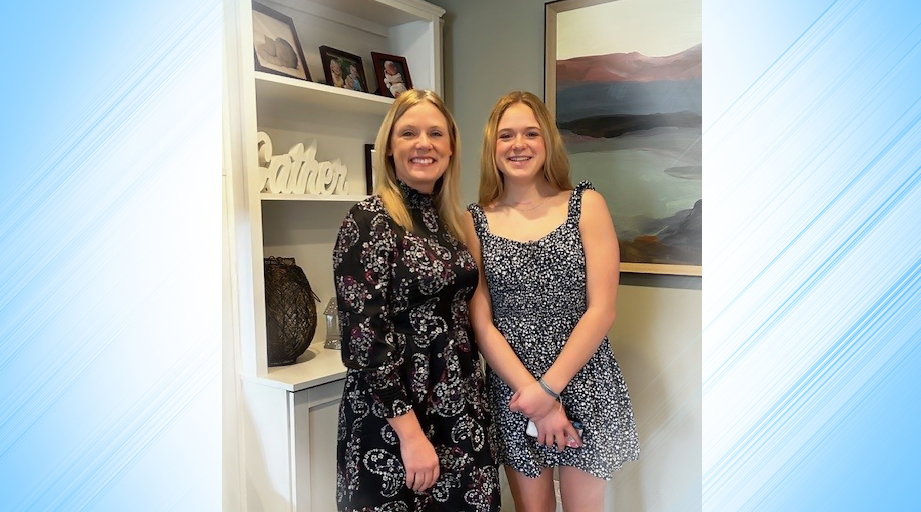
On Sept. 9, 2020, Caroline Berg, then 11 years old, complained of a terrible headache before going to bed.
At first, her mom, Melody Berg, a clinical pharmacist, thought Caroline was having a severe migraine, but she soon called 911. Paramedics raced Caroline to the hospital, where she was found to be having a stroke and needed emergency surgery.
Since May is National Stroke Awareness Month, the Bergs decided to share their story with the ASHP community to encourage pharmacists and others to recognize signs of a stroke in people of all ages.
Recognizing stroke symptoms
Pharmacists tend to think of strokes as more of an emergency event and not necessarily something they’re involved in, said Berg, ASHP’s editorial director for patient medication information.
“But because pharmacists are in the community, people might call or come to us when they or a loved one is having symptoms, and we need to recognize when those symptoms are severe,” she said. “Truthfully, recognition is the biggest thing. If pharmacists can educate and raise awareness that strokes can happen at any age and that a quick response is needed, then further brain damage can be prevented.”
In Caroline’s case, she had gotten home from gymnastics practice and told her mom she had a really bad headache and thought she was dying. Berg offered her Tylenol and suggested she lie down, but Caroline said she wouldn’t be able to sleep because her head hurt too much.
Berg left to brush her teeth. When she returned minutes later, she found Caroline asleep. At first, Berg was surprised to see Caroline had fallen asleep so quickly. However, Berg quickly became concerned after she struggled to wake her child. Caroline was disoriented, saying she thought she was in heaven.
“That is when we knew something was not quite right and called 911,” Berg said.
A call to 911 and emergency surgery
The 911 operator talked Berg and her husband through a stroke assessment after they noticed Caroline’s smile looked crooked — one of the signs of a possible stroke. Then, shortly after paramedics put her in the ambulance, Caroline became combative, possibly due to a seizure, Berg said.
She was transported to the closest pediatric hospital, where a CT scan showed a brain bleed in her right temporal lobe. Doctors rushed her into surgery to relieve the pressure on her brain.

Caroline spent the next 11 days in the intensive care unit while doctors determined the cause of her stroke: an arteriovenous malformation (AVM), a rare mass of blood vessels that causes problems with the connections between arteries and veins. She was allowed to return home but under strict movement limitations to avoid triggering another bleed. A month later, Caroline underwent a second, planned surgery to remove the AVM.
Strokes can happen at any age
“There are so many parents who say, ‘Thank God you called 911 and took her in, because if it had been me and my child, and they complained of a headache and finally fell asleep, I’d be like, great, they’re asleep, and not worry about it,’” Berg said. “Even then, I don’t think I was initially thinking stroke, and even the ER doctor first told me it’s probably just a severe migraine.”

Melody on her first day
home from the hospital.
“We want to make sure people understand that strokes can happen at any age and for various reasons,” she added. “We tend to think of strokes as just being ischemic in nature, but hemorrhagic strokes also can happen, and they are usually a little more life-threatening, so getting patients into treatment quicker is extremely important.”
Recovery and advocacy
Caroline had a long recovery with physical therapy, occupational therapy, and speech therapy. After three months, she returned to gymnastics and had a comeback year. However, she began exhibiting signs of a chronic brain injury and was diagnosed with a genetic condition called hereditary hemorrhagic telangiectasia, which can cause AVMs.
Although Caroline, now 14 and in ninth grade, still has chronic headaches and some other physical ailments, through grit and determination, she has continued to do well in school. She participates in a diving team, does pole vaulting, and teaches children how to swim. She enjoys spending time with her miniature schnauzer dog, Mr. Smithers, named after the doctor who saved her life.
The Bergs volunteer for the Aneurysm and AVM Foundation to raise awareness of the conditions— Caroline as a youth ambassador and Berg as a parent volunteer. They also work to raise awareness about brain injuries, which are chronic, Berg said.
“A lot of the messaging we received post-stroke was that Caroline recovered and doesn’t have any major deficits, and therefore, we should be grateful and move on,” she said. “But it is a chronic illness, and it’s hard. She battles it every day. I don’t think there’s a day that goes by where she doesn’t have to think about her stroke and what happened to her.”
Additionally, Berg started a local chapter of the mother-daughter nonprofit National Charity League in their hometown of Zionsville, Indiana, to help support others in their community. They see it as a way of giving back to people who rallied to support their family by making meals, raking leaves, and giving Caroline gifts to keep her entertained in the hospital and during recovery.
B.E.F.A.S.T.
Berg also wrote an article about stroke prevention for SafeMedication.com, ASHP’s website for consumers with information written by pharmacists. Some potential risk factors for stroke include high blood pressure, excessive alcohol use, heart disease, and diabetes.
The acronym for identifying symptoms of a stroke and getting quick medical attention for someone is B.E.F.A.S.T. :
- Balance (watch for a sudden loss of balance)
- Eyes (check for vision loss)
- Face (look for an uneven smile)
- Arms (check if one arm is weak)
- Speech (listen for slurred speech)
- Time (call 911 right away)








